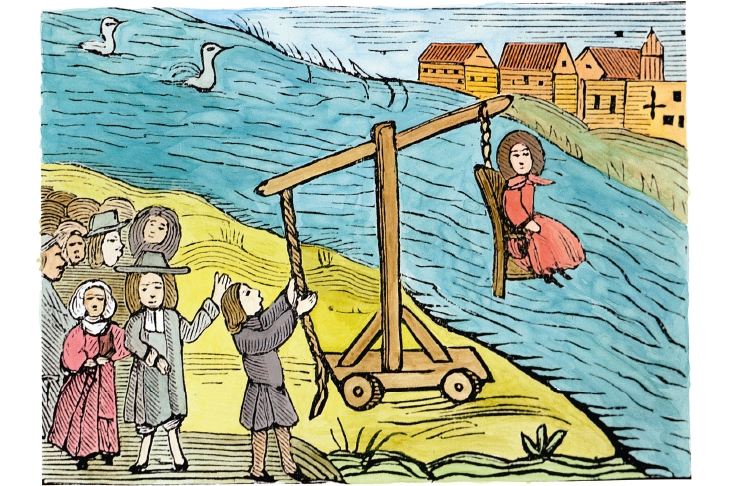Until the mid-1960s many historians believed witchcraft was a pre-Christian pagan fertility ritual, witches worshipping the Horned God, whose consort was the Triple Goddess. The most notable advocate of this theory was the Egyptologist Margaret Murray. Then came revisionists led by Norman Cohn. Examination of witch trials suggested there had been no witchcraft: it was a ‘social construct’ of the Christian patriarchy persecuting innocent women, as it had innocent Jews indicted for the same satanic practices.
Professor Hutton is a follower of Cohn. His study, by ideological necessity, makes no reference to the historical and modern evidence that European witches used hallucinogenic drugs which produced psychedelic sensations of flying, time-space displacement, transformation into beasts, and close encounters, often sexual, with man-beast therianthropes such as the god Pan. The redcap Fly Agaric mushroom, which appears in many pictures showing witches, was one such psychedelic, as was psilocybin. The Solanaceae family of datura, nightshade, Belladonna, henbane, wolfsbane and mandrake give the sensation of flying when rubbed into the mucous membranes of vagina or anus as on a broomstick — and are heart-stopping poisons when ingested in even small amounts.
Sir Francis Bacon (1561–1626) observed that ‘witches believe that they do that which they do not do, transforming themselves into other bodies, not by incantations or ceremonies, but by ointments and anointing themselves’. Two of many studies on witches’ drug-taking are The Witches’ Ointment by Thomas Hatsis and Essential Substances by Richard Rudgley: neither are in Hutton’s bibliography, which contains no reference works at all on the subject. The reason for this omission is obvious: if witches used drugs, in secret, for cult purposes, then contrary to Cohn and the revisionists, witchcraft did actually exist, though was almost certainly not Satan worship.
Hutton also makes no reference to the cases of ergotism in the 16th to 19th centuries, this poisoning by the fungus on rye and barley called ergot, which when baked in bread changes into a chemical similar to LSD that causes visions and convulsions often interpreted as demonic possession. The Salem witch trials occurred in a wet, cold summer favourable to the ergot fungus: the next, hot and dry, produced no reports of demonic possession. Some scholars blame ergot poisoning of both victims and perpetrators for the Salem ‘possessions’.
By logical extension magic and magicians have to be considered ‘social constructs’ and pagan religious relicts surviving into the Christian period are out too. Even pagan magic and drug use in Neolithic Europe are not mentioned. Hutton dismisses Frazer’s Golden Bough in a line. As well as witches, Jews and magicians, the medieval church, state and common people feared astrologers, alchemists, mathematicians, geometricians, herbalists, heretics and even those who could read the Greek alphabet. All arcane, occult knowledge was suspect. Queen Elizabeth I’s astrologer, Dr John Dee, had his house at Mortlake and his library of 4,000 books burnt by an enraged mob which was terrified of his ‘conjuring’.
Hutton mentions that in folklore witches danced with elves, but not that until Shakespeare’s day elves were full-sized men who married ordinary mortals. They were ‘tall and fair’ in Norse and Celtic mythology. They had kings and queens, lived ‘under hills’ (in turf-covered earthen Neolithic barrows), had great knowledge of potions and drugs, ‘danced by moonlight’ with witches, shot ‘elf-bolts’ (flint arrow heads) that killed at a scratch as they were ‘dipped in the dew of hemlock’. Elves were obviously pagan pre-Celtic ancient Britons.
Hutton mentions that witches were accused of eating the flesh of babies, but not that in many cultures mushrooms are called ‘babies’ and ‘holy children’. Sliced redcap Fly Agaric looks like flesh. To accept Hutton one has to excise the whole European herbal tradition, for herbalists have to learn about magic mushrooms and Solanaceae to avoid poisoning themselves and others. Many herbalists were women living in rural areas where herbs were found and collected.
Stephen Oppenheimer in The Origins of the British shows evidence that there was no genocide of ancient Britons by either Celtic or Anglo-Saxon incomers. Genetic sampling shows that 75-95 per cent of the pre-1950 population came from neolithic Iberians who walked here after the last glaciation receded and we were joined to the continent. We are, most of us, descendants of the elves and witches. When you see a photo of a drunken, tattooed yob vomiting in the gutters of San Antonio, watched by a spaced-out chick in a weird hat capering about with a spliff in one hand and bottle of sangria in the other, it’s not decadence, merely modern British elf and witch doing their midsummer solstice thing.
Hutton’s are lo-fat weight-watchers, vanilla witches sans drugs, sans magic, sans pagan rituals, the sort you might meet at a Full Moon party in Ibiza, offering Bodyshop essential-oil rubs for 20 euros a pop. Hutton is in denial: the witches were whacked out of their gourds on a whole Glastonbury of hallucinogenics: they knew about poisons and how to administer them; they provided love philtres and abortifacients.They were, in fact, curanderas, ‘wise women’ deeply versed in the herbal lore their ancestors had learnt from ancient Iberian-British aboriginals, a.k.a. the elves.






Comments